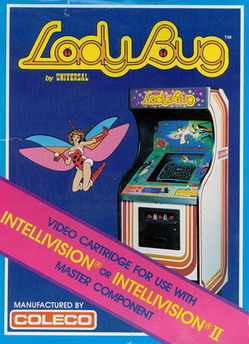Lady Bug (video game)
| Lady Bug | |
|---|---|
 |
|
| Developer(s) | Universal |
| Publisher(s) |
Universal Taito (home versions). |
| Designer(s) | Kazutoshi Ueda |
| Platform(s) | Arcade (original) ColecoVision, Intellivision |
| Release | 1981 |
| Genre(s) | Maze |
| Mode(s) | Up to 2 players, alternating turns |
| Cabinet | Upright, cocktail |
| Arcade system | Main CPU: Z80 (@ 4 MHz) Sound Chips: 2x SN76489 (@ 4 MHz) |
| Display | Raster, 192 x 240 pixels (Vertical), 32 colors |
Lady Bug is an insect-themed maze chase arcade game produced by Universal Entertainment Corporation and released in 1981. Its gameplay is similar to Pac-Man, with the primary addition to the formula being gates that change the layout of the maze when used. The arcade original was relatively obscure, but the game found wider recognition and success as a launch title for the ColecoVision console.
The goal of Lady Bug is to eat all "flowers", hearts and letters in the maze while avoiding other insects. The player is represented by a red, yellow, and green character resembling a ladybug while the enemy insects' appearance varies by level. The border of the maze acts as timer, with each circuit signaling the release of an enemy insect from the central area, up to (generally) a maximum of four. The speed of the circuit increases on stages 2 and 5.
There are eight different enemy insects — a different insect is introduced on each of the first eight levels. Beginning on level 9, each level has four different enemies.
Unlike Pac-Man, the player can alter the layout of the maze by shifting any of the twenty green gates. It is not possible to completely isolate a portion of the maze through gate-shifting.
When the fourth enemy insect enters the maze, the central area will show a level-specific vegetable. Eating a vegetable gives the player bonus points and immobilizes the enemy insects for several seconds, though touching them is still lethal. The randomly placed skull icons are lethal to ladybugs and enemy insects. An enemy insect who dies returns to the central area. Once a vegetable is eaten, the central area will remain empty unless an enemy insect dies and is re-released, revealing a new vegetable. A ladybug who dies will shrink from view and be briefly replaced with icons resembling the stereotypical wings and halo of an angel.
The colors of the hearts and letters cycle through a short red, a middling yellow, and a longer blue. The point values are as follows:
If a heart is consumed while it is blue, a point multiplier will come into effect, indicated by the blue section in the upper right corner of the screen. The first blue heart doubles all point values, the second triples them and the third quintuples them. This multiplier lasts until the level is complete. Eating hearts while they are yellow or red offers no benefit beyond the points collected.
...
Wikipedia
